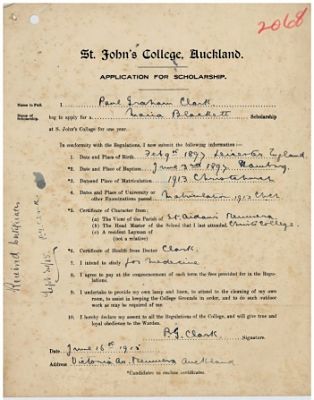WW1 Paul Graham Clark (46224)
Paul Graham Clark (Service number 46224) was born on 9 February 1897, in Leicester, Leicestershire, England, the son of Dr Alfred Clark and Isabel Clark of Cerne Abbas, Victoria Avenue, Remuera and formerly 12 Domett Avenue, Epsom, Auckland, New Zealand.
Paul and his family came to Ashburton from England when Paul was about 6 years old in 1903. His sister was Constance Duthie who was the founder and first principal of Corran School from 1947 to 1960.[1] [8] [9]
He was educated at Christ’s College, Christchurch, and, in addition to being most successful in his studies, he took a prominent part in college sports, playing in the college representative rugby fifteen for three years. Before enlisting he was a temporary assistant-master at King’s College. [2]
As part of territorial training he was a member of the 35th Parnell Senior Cadet Corps. In 1916, he was in the Rifle Club team that won the Haslam Shield that year, where all members of the winning team went to serve in World War. The Haslam Shield was a trophy, donated by Professor Haslam of Canterbury College (now University of Canterbury) in 1909 as a rifle challenge amongst the four university colleges in New Zealand [3]
Whilst Paul was at Auckland University College (now the University of Auckland) studying medicine he applied to St John’s Theological College in Auckland and was accepted for a ‘Maria Blackett Scholarship’ in 1915. The Scholarship had been established in 1847 by John Charles Blackett, following the death of his wife, Maria. The Maria Blackett Scholarship Trust, was financed by the conveyance of his land at “Somerville’s corner” in central Auckland which became known as Blackett’s Building. The building is now used as shops and offices. Maria Blackett scholarships are still awarded to students of St. John’s College, Auckland University. [4]
In the archives at the John Kinder Theological Library there is correspondence from Paul Graham Clark to the St John’s College Trust Board requesting leave of absence from the college and if they would hold his scholarship for him until his return from the war. As he was a first-year medical student and because he was underage, he was debarred from serving with the New Zealand Expeditionary Force. He wrote to request to serve his country, as even with the scholarship, he could not afford to continue his studies to become a Doctor. If he went to war, he suggested that he would gain both experience and save enough money to attend medical school on his return from war [5]
At last he was accepted and enlisted on 6 December 1917. He was 5ft 11 inches tall, with fair hair and blue eyes. He was appointed a Second Lieutenant in camp in August 1917. He embarked on 8 February 1918 on the vessel ’Ulimaroa’, arriving on 29 March 1918 in Liverpool, England. He requested to fight as a Non-Commissioned Officer, but was not approved as he was under the age of 20 at the time, so remained 2nd lieutenant in the 34th Reinforcements, Auckland Infantry Regiment, A Company New Zealand Expeditionary Force. He left for France and the Western Front from England on 2 May 1918 and was transferred to the New Zealand Rifle Brigade. His father Dr Alfred Clark (3/1538) served with the N Z Medical Corps.
August-September 1918 saw the Battle of Bapaume which was one of the New Zealand Division’s final offensives of the war. On 21 August the British Third Army (with the New Zealand Division as part of its IV Corps) launched an attack north of the Somme battlefield, intending to drive the Germans back towards the town of Bapaume. The area was chosen as it was less torn-up by years of shelling, and thus better suited to mobile attacks with armoured support and eventually pushed the Germans back to the Hindenburg Line east of Bapaume, the area from which they had launched their Spring Offensive in the previous March [6]
Paul Graham Clark was killed in action fighting in Bapaume, France on 26 August 1918. His death was reported by the Reverend J. S. Smith who was attached to the 22nd New Zealand Rifle Brigade. He was aged 21.
Paul Graham Clark is mentioned in the Kings College and the Auckland University College (University of Auckland) Rolls of Honour. His name is on the Celtic memorial cross at St Aidan’s Church, Remuera and on a carved oak font cover in the church, which the Bishop of Auckland, Dr A.W. Averill, dedicated to the memory of Lieutenant Paul G. Clark on 27 April 1919.
. His memorial is at the Achiet-le-Grand Communal Cemetery Extension, Pas-de-Calais, France Grave reference, III. F. 28. [7] He was posthumously awarded the British War medal and the Victory medal. After the war his father Dr Alfred Clark was a driving force for the erection of the Memorial Lychgate which stands outside St Aidan’s Church. [8]



